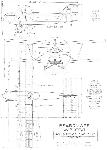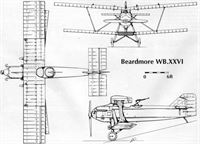
Flight, August 1925
THE BEARDMORE W.B. XXVI
A Two-Seater Fighter of Unorthodox Design and fitted with 375 H.P. Rolls-Royce "Eagle IX”
THE first "large" aeroplane to be designed by Mr. W. S. Shackleton after joining William Beardmore and Co., Ltd., and which is now nearing completion, is the W.B. XXVI, which forms the subject of our scale drawings this week. The machine is of somewhat unusual design, and incorporates a number of interesting features. The W.B. XXVI was specially designed for use as a high-performance two-seater fighter, and Mr. Shackleton chose the biplane arrangement, partly on account of its greater rigidity and lower weight, and partly to provide a better field of view. At the same time he has made an attempt to equal, or at any rate approach, the monoplane type in aerodynamic efficiency by the suppression of wing bracing wires and by using a large gap/chord ratio.
Unfortunately, photographs of the finished machine are not available, but the scale drawings give a very fair idea of the general arrangement, while certain features, not readily detected in the scale drawings, are shown in the photograph of the wind tunnel model. It will be seen that the flat-sided fuselage is of fairly small cross-sectional area, and is not directly attached to either upper or lower plane, the top plane roots being anchored to cabane struts from the top longerons, and the lower plane centre-section bolted to a fin built integral with the bulkheads of the fuselage.
The biplane wings are rigidly braced by three struts on each side, one being the interplane I-strut with forked ends, and the other two compression struts running from the top longerons to the lower wing spars. The attachment to the fuselage is by pin joints, so that the wings can be quickly dismantled and re-erected. Furthermore, no adjustment of any kind is necessary after the final trueing up of the machine, the wings being rigidly locked in position merely by inserting the necessary bolts and pins. This feature should be particularly valuable in the field, and should save a great deal of time.
The pilot's and gunner's cockpits are placed very close together, so that the closest co-operation between them should be possible, and the view from both cockpits should be particularly good, the more so as the top plane is thinned-down towards the centre so as to enable the crew to look over or under it with a minimum of obstruction.
The armament consists of three Beardmore-Farquhar machine guns: two fixed guns firing through the propeller and controlled by the Constantinesco interrupter gear, and the third operated by the gunner and mounted on the usual Scarff gun-ring. The rear gun is so mounted in relation to the wings and fuselage that it can be operated almost throughout the entire upper hemisphere, while in a downward direction, owing to the fact that the gunner's cockpit is aft of the trailing edge of the lower plane, the gun can be fired almost vertically, an angle of 10 degrees only beyond the vertical being obstructed by the fuselage. In order to improve the field of fire aft, the vertical fin is of the cantilever type without external bracing, while the tail plane is braced by one strut on each side, running to the lower longerons. There is thus no risk of the gunner accidentally shooting away any bracing struts of the tail.
The Fuselage
The fuselage is built up of spruce longerons with bulkheads of spruce and three-ply. The covering is in the form of birch three-ply, so that once the fuselage is erected there is no trueing up to be done to it, and it should require a minimum of attention in service. The fuselage is subsequently covered with fabric to protect the joints, and is painted and doped to give a watertight surface. The fin carrying the lower plane, etc., is, as already mentioned, built integral with the fuselage bulkheads so as to obtain the necessary rigidity in the wing structure. A fireproof bulkhead is fitted at the front of the fuselage, and all parts forward of this are of steel. The engine bearer is of simple and rigid type and is specially designed to allow of the rapid removal of the complete engine unit.
The engine is a 375 h.p. Rolls-Royce "Eagle IX," totally cowled-in with the exception of the exhaust collectors, and a particularly neat nose has been made possible by employing a special type of Lamblin radiator. This radiator is located on the leading edge of the bottom centre section, a position which combines the advantage of good accessibility with very small drag.
The petrol tanks ate mounted in the top plane, one ahead of the front spar and one aft of the rear spar, on each side, and arc shaped to follow the curves of the wing section. Owing to the height above the carburettor, this arrangement of the tanks simplifies the petrol system by giving direct, gravity feed, and the fact of having a set of tanks on each side should considerably minimise the risk of the machine being brought down by machine gun bullets piercing all the tanks.
Wing Structure
Although differing somewhat in size, the upper and lower planes are of identical construction, each comprising two box spars of spruce with ribs made of spruce and three-ply. The whole of the wing, from the leading edge to the back spar, is covered with ply wood, a form of construction which gives great resistance against drag forces and stiffens the wings considerably against torsional loads. Ailerons are fitted on both top and bottom planes, and are operated by direct-acting rods and cables, the whole of the mechanism being carried inside the wings, with sliding doors for adjustment and inspection of various parts. The two lift struts running from the fuselage down to the bottom plane are of steel tubing, with duralumin fairings riveted on. Only one of these struts is adjustable, and, as already pointed out, when this has once been screwed up there is no necessity for further adjustment. The interplane I-strut is of built-up duralumin plate, and is faired off to a streamline form. Adjustment is provided at top and bottom, on the rear spar only, so that the correct angle of incidence may be obtained when the machine is being erected in the first instance. The wings are covered with linen fabric laid on at an angle of 45° to the leading edge. This method of applying the fabric considerably increases the resistance of the wing against drag forces, and has the further advantage of confining any tears to a small locality, as the tear cannot spread beyond the nearest rib.
The Undercarriage
The undercarriage is of all-metal construction, and contains no rubber or other perishable material. The landing shocks are taken on a novel system of spiral springs under compression which are provided with a special patented system of damping in which Ferrodo friction blocks are employed to prevent the machine from bouncing. The telescopic front legs of the undercarriage run to the lower longerons of the fuselage, while the bent axles and rear chassis struts are connected to the vertical fin at the points of attachment of the lower wing spars. It might be mentioned that a special feature of the undercarriage is the long travel provided, which is no less than 9 1/2 ins., so that landings on even very rough ground should be possible.
The Tail Unit
Reference has already been made to the fact that the tail unit has been designed with a minimum of bracing, so as to improve the gunner's field of fire. A novel feature of the tail plane is that instead of the usual trimming tail, which is somewhat difficult to carry out on a cantilever or semi-cantilever structure, Mr. Shackleton has designed a hinged leading edge operated from the cockpit, which has the effect of giving a positive or negative camber of the tail plane instead of the more usual positive or negative angle of incidence. It is possible, by suitable adjustment of this leading edge, to obtain a neutral trim or "feel" of the control lever at all flying speeds. The tail skid is of all-metal construction, and landing shocks are taken by steel springs. Practically no replacement should be required in service beyond renewing the tail skid shoe, which is made readily detachable.
The main dimensions of the Beardmore W.B. XXVI are shown on the general arrangement drawings. The following are the item weights of the machine: Weight empty (without armament), 2,555 lbs.; petrol (75 galls.), 545 lbs.; oil, 50 lbs.; water, 70 lbs.; pilot and gunner, 340 lbs.; armament (three guns and ammunition), 320 lbs.; oxygen apparatus, camera, etc., 100 lbs.; total loaded weight, 3,980 lbs. Power loading, 10 lbs./h.p.; wing loading, 11-18 lbs./sq. ft. The following are the estimated performances: Top speed at ground level, 145 m.p.h.; landing speed, 57 m.p.h.; climb to 15,000 ft. in 20 mins. Ceiling, 20,000 ft.; duration, approximately 4 hrs. at cruising speed.
Описание:
- Flight, August 1925
THE BEARDMORE W.B. XXVI - Flight, November 1925
A NEW BRITISH AEROPLANE FOR LATVIA - Flight, February 1926
THE BEARDMORE W.B. XXVI
Фотографии
-
Aeroplane Monthly 1996-12 / P.Jarrett - Limited editions (4)
The WB.XXVI in its later form, with separate exhaust stubs. Its all-wooden construction would have ruled out Air Ministry interest by this time.
-
Flight 1926-02 / Flight
A MANOEUVRABLE MACHINE: The Beardmore W.B. XXVI has recently been put through some severe performance and controllability tests, from which it has emerged with flying colours.
-
Aeroplane Monthly 1996-12 / P.Jarrett - Limited editions (4)
The WB.XXVI, with separate exhaust stubs, being manhandled by groundcrew at Renfrew.
-
Aeroplane Monthly 1996-12 / P.Jarrett - Limited editions (4)
An extremely rare shot of the WB.XXVI in a hangar on the military airfield at Spilve, near Riga, in 1927. It flew only briefly in Latvia before being rejected.
-
Flight 1925-12 / Flight
NEW BRITISH AEROPLANE FOR LATVIA: Tha Beardmore W.B.XXVI is a two-seater fighter with Rolls-Royce "Eagle IX" engine. This three-quarter front view shows the unusual wing bracing and the special undercarriage "leg," which gives a travel of no less than 11 in.
-
Aeroplane Monthly 1996-12 / P.Jarrett - Limited editions (4)
The Beardmore WB.XXVI shortly after completion, in the autumn of 1925, before the undercarriage leg fairings had been fitted and with the original exhaust manifolds.
-
Flight 1925-12 / Flight
The machine gun and its Scarff ring mounting on the Beardmore W.B.XXVI.
-
Aeroplane Monthly 1996-12 / P.Jarrett - Limited editions (4)
A close-up of the unusual 0-303in Beardmore-Farquhar machine-gun on the rear cockpit Scarff ring.
-
Flight 1926-02 / Flight
Undercarriage of the Beardmore W.B. XXVI two-seater fighter.
The patented undercarriage used spiral steel springs under compression. Note the Lamblin radiator on the centre section. -
Flight 1925-08 / Flight
The Beardmore W.B. XXVI, 375 h.p. Rolls-Royce "Eagle IX" engine. This photograph shows the wind tunnel model of the machine.
-
Aeroplane Monthly 1996-12 / P.Jarrett - Limited editions (4)
Two views of the 1/10th-scale windtunnel model of the WB.XXVI tested at RAE Farnborough in late 1924/early 1925.
-
Flight 1925-08 / Flight
Beardmore W.B.XXVI Rolls-Royce "Eagle" IX Engine
-
Aeroplane Monthly 1996-12 / P.Jarrett - Limited editions (4)
Beardmore WB.XXVI
- Фотографии












